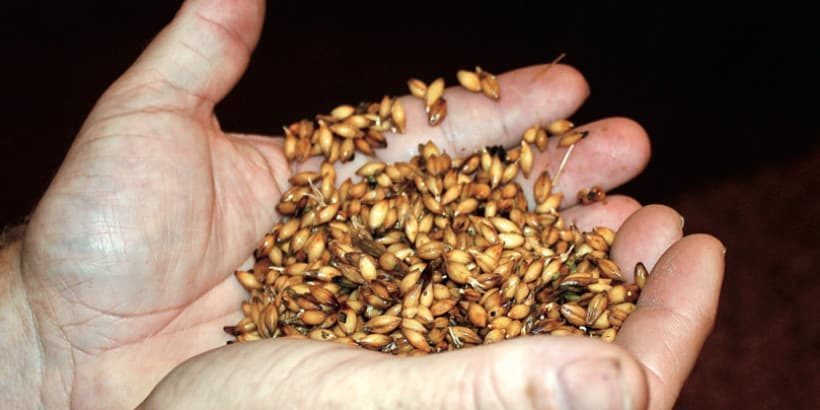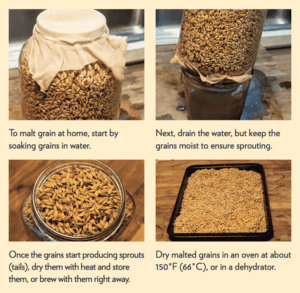Malt Your Own Grain at Home: Brewing from Scratch

Do you think making a 100%-from-scratch beer is near-to-impossible? We’re here to tell you, it’s not! With just a few ingredients and a little patience, you can malt your own grain at home and get started on a brewing a batch of beer completely from scratch!
The following excerpt is from Brew Beer Like a Yeti by Jereme Zimmerman. It has been adapted for the web.
(Photographs courtesy of Jereme Zimmerman unless otherwise noted.)
Malt Your Own Grain at Home
It’s quite simple to malt your own grain. All you need are whole, unhulled grains, water, and a bit of patience. Barley works best due to its high potential for enzyme conversion, but other grains such as sorghum or field corn (dried, not sweet and right off the cob) will work as well. I recommend starting with enough for a 1-gallon (4 L) batch of all-grain beer, as it will help you to understand the process before you try malting larger amounts. Once the grains are malted, you can follow my technique for 1-gallon all-grain brewing in chapter 8, and you’ll have the pleasure of being able to say that you made a batch of beer entirely from scratch! You can easily scale up from there. The whole process should take two to three days.
Ingredients and Equipment
- 2 pounds (1 kg) unhulled barley or other whole grain
- Around 1⁄2 gallon (2 L) warm springwater or dechlorinated tap water (enough to cover the grains)
- Widemouthed 1-gallon (4 L) or larger glass jar
- Cheesecloth or dish towel with a rubber band, or sprouting lid (basically a lid with a fine-mesh screen)
Procedure
- Fill the jar with grains up to about 2 inches (5 cm) below the opening, to allow room for them to swell. Cover the grains with the water and secure a sprouting lid, or use a rubber band to secure a cloth, over the jar’s opening.
- Let the grains soak in a warm area (60–70°F/15–21°C or higher) for 12 to 24 hours.
- Sometime between the 12- and 24-hour mark (wait longer in cooler temperatures), drain all water off, or the grains will ferment and eventually rot. To do this, let the jar sit upside down in a bowl or draining rack, making sure it is not resting in the drained water. The grains will only germinate if they’re moist but not covered by water, as they require both water and oxygen to sprout.
- Place the jar back in its warm area and proceed to rinse the grains two to three times (or more) a day; be sure to drain off all water each time. You want them to stay moist, but keep from molding.
- Watch for sprouts (tails) to start emerging from the seeds. Once the tails are about three-quarters the length of the seed, they are at peak fermentation viability. Use them within a day or store them for a couple of days in a refrigerator, as the enzymes and sugar will diminish quickly.
- If you plan on saving them for later, dry them in an oven at about 150°F (66°C) or in a dehydrator. Dry them until they are too hard to bite through when put between your teeth.
- If desired, roast the grains before storing (using the Roasting Your Own Malt guidelines on page 64).
- Store the grains in an airtight container in a cool place until you’re ready to use them.
Recommended Reads
Recent Articles
Garlic mustard: while known as “invasive,” this plant can be consumed in its entirety and has great nutritional value. Plus, the garlic-flavor is a perfect addition to any recipe that calls for mustard! The following are excerpts from Beyond the War on Invasive Species by Tao Orion and The Wild Wisdom of Weeds by Katrina…
Read MoreOh, honeysuckle…how we love thee. If only there was a way to capture the sweet essence of this plant so we could enjoy it more than just in passing. Luckily, foraging and some preparation can help make that happen! Here’s a springtime recipe that tastes exactly like honeysuckle smells. The following excerpt is from Forage,…
Read MoreIntroducing…your new favorite brunch dish! This whole broccoli frittata is packed with fresh, wildcrafted flavors that are bound to help you start your day off on the right foot. The following is an excerpt from The Forager Chef’s Book of Flora by Alan Bergo. It has been adapted for the web. RECIPE: Whole Broccoli Frittata…
Read MoreWondering where to forage for greens this spring? Look no further than hedges, which serve as natural havens for wild greens and herbs! The following is an excerpt from Hedgelands by Christopher Hart. It has been adapted for the web. Food from Hedges: Salads and Greens Let’s start by looking at all the wild foods…
Read MoreThere’s a whole new world out there when it comes to koji. It doesn’t matter if you’re making bread, cheese, or ice cream, koji helps you pump up the flavor! Growing Koji in Your Own Kitchen Koji, the microbe behind the delicious, umami flavors of soy sauce, miso, fermented bean sauce, and so many of…
Read More










